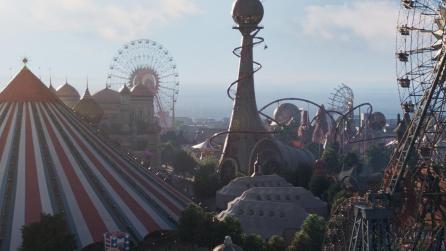Five look development and lighting trends to watch out for in 2020
If there’s one thing we can say for look development and lighting, it’s that 2020 will be a busy year.
As another Christmas looms large, the demand for visual effects & animated content continues to grow at a staggering rate. With this growth comes a drive for higher-volume, higher-quality CGI, often with no additional time or budget allocated.
As we’ll touch on below, our and others ongoing efforts in look development and lighting revolve around trying to solve this paradox—creating assets and animation to a certain specification, on time, and within budget.
With that in mind, let’s jump in and take a look at the five key look development and lighting trends we’ve identified for 2020—and what they mean for the industry.
GPU vs CPU rendering
Traditionally, CPU rendering has been the tried and tested method used by artists and studios to produce their final images and assets.
It’s less restrictive and typically enjoys support from most render engines, making it widespread and predictable, especially for medium to larger studios.
But here’s the rub—CPU rendering has a tendency to take its sweet time. As look development and lighting efforts scale to meet the demands of bigger projects and tighter deadlines, there’s an emerging sentiment that CPU rendering might not be up to doing the job in time.
As a result, there’s been a shift toward GPU rendering.
Since GPUs cannot use system RAM in a high-performance manner, they instead rely on Video-RAM (VRAM) resources to load and store scene data. VRAM’s proximity to GPUs allows for the GPU renderer to process data much more quickly. What CPU can render in two hours, GPU may be able to in fifteen minutes.
This may sound perfect—but it’s not for everyone. Studios looking to invest in GPU rendering need deep pockets to afford the amount of graphics cards to provide sufficient VRAM needed to render enormous scenes in such a short time-frame. Otherwise, they’re faced with the logistics around decreasing the VRAM footprint of their work to fit the available GPU resources.
There’s also a concern with GPU rendering that the bandwidth needed between software and hardware to deal with large operations hasn’t been figured out yet for all production scenarios. In this case, the transferring of data between CPU resources and GPU resources becomes the bottleneck, slowing the whole thing down.
This can cause pushback on GPU rendering, and a shift back to CPU.
Whilst it’s a constant pendulum swinging back-and-forth, 2020 might provide some insight into which way it’s going to go—and stay. The main question to ask is: will the graphics card providers be able to create a graphics card with enough resources to do production rendering at a price that makes it practical for the majority of studios?
If yes, then we could see the popularity of GPU rendering correlating with the rising capabilities of VRAM and GPU technology.

Cloud rendering
Then there’s a third contender in the rendering war, and it’s giving both GPU and CPU on-premise rendering a run for their money.
Cloud rendering is often used to deal with capacity by scaling up to massive amounts of machines on the “farm”. Studios and artists who need to render thousands of costly frames may not have enough resource to do this, so instead they ‘borrow’ a farm with 100s to 1000s of machines to satisfy their temporary need and get the final renders faster.
This method of rendering comes at a crisis point in discussions surrounding clients, workflows, and deliverables, particularly as ever-tighter deadlines are imposed.
In principle, cloud rendering sounds great. But put in practice, the reality is somewhat different - not least because the render farm model has its own challenges to overcome.
Cloud rendering follows a variable cost model whereby studios and artists pay for iterations as and when they occur. This can lead to overspending, unstable budgets and uncertainty over the cost of producing a shot with foresight.
On the other hand, CPU and GPU rendering are both fixed costs. Users of these methods can work out their budget before production and stick to this rigidly throughout the look development process.
Cloud rendering also raises concerns over security, with some studios eschewing it entirely out of fear that their IP may get swallowed up by the World Wide Web. We bust that myth here, but internet security concerns are an age-old problem that aren’t easily soothed.
So is the future of cloud rendering...up in the air? Puns aside, we’re inclined to believe that should cloud rendering become cheaper, whilst massaging concerns over cost variants, it has the potential to become the industry-standard rendering method. 3Delight Cloud and Chaos Cloud are trying to address both the artist and business concerns of cloud rendering and worth investigating in 2020.
Stepping back slightly, the ongoing render battle we’ve highlighted fits into wider discussions surrounding resource, time and money.
In light of this, there seems to be an ongoing Tetris-style debate between the cost of people vs the cost of processing vs how much can be automated that will only continue into 2020 - and beyond.

Universal Scene Description (USD)
Earlier this year, we wrote about the impact that USD is set to have on the VFX industry - and it’s certainly been gaining momentum as the months roll on.
As 2019 comes to a close, USD is still enjoying its time in the limelight. With a rapid release schedule that sees new iterations coming usually every two or three months, it’s barrelling into 2020 as the hot topic on everyone’s lips—with no hint of slowing down.
But the question begs: has it started running before it can walk? Or does the excitement for USD’s potential not reflect the early days of USD development?
USD technology is still young and in development, changing for the better each month as growing pains and teething issues are ironed out. There are calls for a universal application of USD so it can exist in pipelines as an application-standard plugin. If this comes off, documentation could be made uniform, and information could be shared across software, teams, and studios with even more ease and efficiency.
This all depends on if USD can catch up to itself in 2020.
We touched on Foundry’s own efforts in the USD space in this article. Currently, we are also bringing USD I/O plugins to our applications in binary form as well as open-sourcing the source code for those plugins. This will allow the best of both worlds for studios without and with software teams that customize USD usage.
We’re also working on developing Foundry’s Advanced Viewport technology to run as a Hydra render delegate inside of Katana, displaying USD assets with their UsdShade Preview Surface descriptions.
The aim is to deliver a digital content creation ‘what you see is what you get’ workflow across Modo, Mari and Katana—so an asset painted in Mari will look the same in the Modo or Katana viewports. Read more about it here.

A common interchange format for look development and lighting artists
Consistent looks across multiple DCCs and rendering softwares has always been something of a nightmare. What one artist sees working with a file may be completely different to what their colleague sees when opening the same file in a different combination of tools. This causes pipeline issues and inefficiency.
For consistency’s sake, artists ideally want to manage their data in one format, with digital content creation applications supporting said format.
The challenge here lies in unpicking the different technology and shaders used in popular render engines like RenderMan, Arnold, V-Ray, Redshift and 3Delight, and remapping these to create a common interchange format.
UsdShade - developed by Pixar - and MaterialX - originating at Lucasfilm - are spearheading inroads into this space, with the latter recently replicating its unified surface shader in a range of different digital content creators.
To do this, ILM recorded each look developed in the various DCCs, and then saved these in the document format MaterialX. This could then be opened in a bunch of different applications - whether that be a game engine, or Katana, or Mari - and the look would be consistent.
UsdShade are trying to do the same thing by describing the common components to a look so that these can be recognized consistently across any DCC. In this way, powerhouses Pixar and ILM are working together toward a common goal of consistent visualization - which is good news for artists’ pipelines everywhere.
Proceduralism vs handcrafted assets
The need to deal with high volumes of textured assets has increased throughout 2019, and shows no signs of stopping as we move into 2020.
Mounting pressure from clients to create textures and assets at scale without sacrificing quality - say, for example, when an entire city needs to be recreated digitally from buildings down to rubbish bins, and smaller set dressing items - means studios and artists are forced to find smarter ways of working, with vendors being pushed to accommodate this.
Proceduralism offers a solution in these instances. Through it, artists can create and apply ‘rules’ or ‘steps’ to a vast array of assets, press a button, and the end result counts as most of the work done and dusted.
Its popularity has steadily been gaining momentum. Now, it’s at a point where procedural workflows are replacing traditional, bespoke painting and texturing to a bittersweet end.
There’s no doubt that proceduralism automates and quickens what has traditionally been quite a manual, laborious task, but a rising number of industry veterans are asking: at what cost?
In this article, Framestore’s Head of Texturing Michael Bohri tells us: “[Procedural texturing]...facilitates a part of the texturing job, it is one of many tools, and is not an end in itself. There is always an aspect of the workflow, that despite even the best methods, still manages to look...procedural, or formulaic.”
And as concerns like these continue to emerge, so too is there an increasing onus on artists to give their look development assets a ‘story’. A shield should have dents and scuff marks; statues should show age and exposure through suitable patinas; and so on.
Some argue that using a procedural material preset in these instances does not cut the mustard. Craft, artistry and visual storytelling is needed to meet the final quality threshold needed by clients - yet there is a danger of these becoming subsidiary as part of a procedural workflow.
To counteract this, software vendors are pushed to ‘sell the realism’ of proceduralism, so any assets produced procedurally have the same detail and finesse as those that are handcrafted.
This is a trend Foundry foresees gaining momentum as we move into 2020 and beyond.

The future’s bright…
It’s an exciting time to be an artist in look development and lighting. If there’s one thing we feel confident in saying for certain, it’s that 2020 is geared towards making your life easier - from the rising adoption of open standards to more discerning means of texturing and rendering.
This extends to studios, too, as workflows synchronize for unbridled creative collaboration across teams, all whilst saving time.
Watch this space.
Want to hear more about the trends set to shape the VFX, VR and Design industries?
Sign up to our quarterly Trends newsletter below

